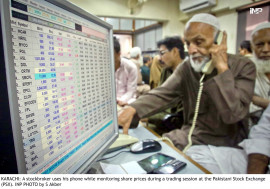
The World Bank reported Thursday that Pakistan's inflation will remain in double digits and the economic growth will also remain only 2.8% this fiscal year. This growth rate is insufficient to reduce the rising poverty rate, which has climbed to 40.5%.
In its Pakistan Development Update, the World Bank highlighted that while the country has averted a full-blown economic crisis, the successful implementation of pending reforms is crucial to stabilise the economy. The government is expected to miss key economic targets, including public debt reduction and, more importantly, the International Monetary Fund (IMF)'s mandated budget surplus. Tight macroeconomic policies, elevated inflation, policy uncertainty, and unaddressed structural constraints continue to stifle economic activity, the report states.
The World Bank's macroeconomic projections are more conservative than those of the IMF, which forecasts slightly higher growth and lower inflation for Pakistan.
"The message is clear: Pakistan has stabilised its economy but macroeconomic vulnerabilities due to significant macroeconomic challenges remain," said Mukhtarul Hasan, lead author of the report. He noted that current growth is not enough to reduce the already high poverty rate of 40.5%.
The report shows Pakistan's economic growth at 2.8% this fiscal year, below the government's target of 3.6%. Even next year, growth is forecast to reach only 3.2%.
Franziska Ohnsorge, Chief Economist for South Asia at the World Bank, stated that while the South Asia region is poised for solid economic growth, Pakistan's outlook remains sobering due to rapid population growth. The projected economic growth will only marginally improve incomes and living standards over the medium to long term.
The two-year growth projections are not enough to generate jobs for the 3.5 million people expected to enter the labour market in the next two years, said Tobias Haque, a senior economist at the bank. "Little progress will be achieved in reducing poverty from the current high level of 40.5%," the report states.
The poverty rate is estimated to have risen to 40.5% by the end of June, up from 40.2% the previous year, driven by low economic growth, high inflation, and declining labour incomes. While official remittances increased by 10.7% last fiscal year, their real value declined due to exchange rate depreciation and elevated inflation.
The World Bank forecasts that inflation will remain around 11.1% for the current fiscal year, a figure slightly better than the government's expectations but higher than the IMF's projection of 9.5%. Food inflation eased last year, providing some relief to low-income households, but this was offset by high energy costs and elevated core inflation, especially in rural areas.
The report suggests that further cuts to the policy rate are likely as inflation moderates. However, the World Bank did not comment on whether the current exchange rate of Rs279 to the dollar reflects the true value of the rupee or if the currency is undervalued.
The energy sector poses a significant risk to Pakistan's fiscal sustainability and economic recovery, said Waqas Idrees, co-author of the report. The financial burden on the economy from the energy sector demands urgent reforms, he said.
The report also states that Pakistan's current account deficit is expected to remain around 0.6% of GDP, in line with official estimates. However, imports are expected to increase as investment and industrial activity recover, unless measures are taken to manage them.
The World Bank also raises concerns about Pakistan's fiscal deficit, projected to increase to 7.6% of GDP (Rs9.4 trillion) this fiscal year, much higher than the government's estimate of 5.9% (Rs7.3 trillion). The country is also expected to miss its primary surplus target of Rs1.2 trillion (1% of GDP), with the World Bank estimating a surplus of only 0.7%.
Next fiscal year, the primary balance is projected to turn into a deficit of 0.2% of GDP. The report warns that gross financing needs will remain significant due to maturing short-term debt, multilateral and bilateral repayments, and Eurobond maturities.
Public debt is expected to reach 73.8% of GDP this fiscal year and further rise to 74.7% next year. The report stresses the importance of sustained fiscal consolidation measures to restore fiscal and debt sustainability.
The World Bank stresses that Pakistan's economy is on the path to recovery, but sustained positive momentum requires the full implementation of structural reforms. These reforms include addressing an inequitable and distortive tax system, reducing inefficient expenditures and untargeted subsidies, lessening state intervention in the economy, and reducing trade and investment barriers.
Najy Benhassine, World Bank Country Director for Pakistan, stated that structural reforms, supported by strong political consensus and increased private sector participation, are crucial for mitigating risks and supporting stronger, private-led growth.
The energy sector offers opportunities for improvement through private sector participation in power distribution. Idrees explained that involving the private sector could lead to better customer service, reduced losses, improved management, and new investment. However, these outcomes depend on favourable government policies and strong political backing.
Most power distribution companies (DISCOs) in Pakistan are operating at a loss, with liabilities exceeding their assets. DISCOs in Peshawar, Quetta, Sukkur, and Hyderabad are particularly vulnerable due to high transmission and distribution losses and poor recovery rates for electricity bills, said Idrees, adding that last year, the total cost of electricity for the sector was Rs2.9 trillion, while revenues, including subsidies, reached only Rs2.6 trillion.



1728613438-0/Henry-Cavil-(1)1728613438-0-165x106.webp)
1726745394-0/Tribune-Pic-(15)1726745394-0-165x106.webp)













COMMENTS
Comments are moderated and generally will be posted if they are on-topic and not abusive.
For more information, please see our Comments FAQ